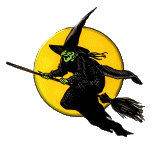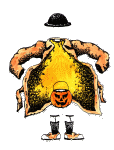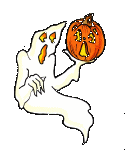
 Stein Collectors International
Stein Collectors International
Featured Stein: October 2004

 Stein Collectors International
Stein Collectors International
Featured Stein: October 2004
  ~ Houdini in a Milk Can ~ by Ronald E. Gray |
||
October brings us Halloween, All Saints' Day, which was brought to America by immigrants from Ireland in the 1840s. Interestingly, a hollowed out turnip was originally used for the jack-o'-lantern. The Irish switched to the pumpkin because it was more readily available in America. Halloween is also the anniversary of the death of one of the world’s best-loved and most-traveled magicians, Harry Houdini. He died of peritonitis poisoning as a result of a ruptured appendix in Detroit on October 31, 1926 (which was Halloween). Known for his ability to take a punch in the stomach, allegedly a fan hit him in the stomach before he was prepared thus causing his appendix to rupture. Erik Weisz was born in Budapest, Hungary, on March 24, 1874. His family immigrated to the United States when he was four and, as happened to many families entering the new world, the spelling of their name was changed. Houdini’s name thus became Ehrich Weiss. The family initially settled in Appleton, Wisconsin. It was Appleton that he claimed as his place of birth for most of his life. When Ehrich commenced his entertainment career, he adopted the stage name of Harry Houdini, the surname being based on a popular magician named Robert Houdin. Houdini even authored a book on Houdin. Houdini’s escape acts, which gained him his fame, were performed worldwide to sell-out crowds, including command performances before royalty. This new character stein shows him doing one of his famous escapes in a milk can, first performed in St. Louis in 1908. The stein was made for Domex Geschenk-Manufaktur GmbH, with the body being made in China and the final assembly being done in their plant in Germany, a cost-saving production procedure done with most of their steins. The stein was made in a limited numbered edition of 500 for Appleton Brewery, brewers of Houdini’s Escape Stout and Houdini Root Beer & Soda. Pete Kroll, an SCI member, assisted Appleton Brewery with the project. Domex is a contemporary stein company with the principals having family ties to the stein makers Alwe and Rastal. Domex was founded in 1991 in Hillscheid in the Westerwald region of Germany. When the firm of Simon Peter Gerz went out of business in 1999, Domex bought the Gerz name and logo. Domex later started another firm with the name of Simon Peter Gerz GmbH. Domex does not make steins, but rather is a finisher of steins made elsewhere, including Germany and China. Manuel M. Weisbender of Domex has informed me that the company feels they get a higher quality ceramic stein from the plant in China at a slightly lower cost. Domex trained employees of the small Chinese plant in the Westerwald techniques used to make ceramic steins. The Gerz firm is a marketing company that has an art department to help customers design a stein. The Appleton Brewery name appears on the bottom of 350 steins, with the remaining 150 steins being blank. Only the first 350 show the Gerz logo and neither version shows the country of manufacture. The steins, which come shrink wrapped, are supposed to have a sticker disclosing the country of origin, although I do not recall such a sticker on my stein. Domex, however, is known for marking their steins with a sticker that can easily be removed. Appleton Brewery can be reached at (920) 735-0507 to purchase the stein, which they are selling at $79.95 plus shipping. Pete Kroll of Glasses, Mugs & Steins also has been selling the steins on eBay, although some may be unmarked. My character stein came with a bottle of Houdini’s Escape Stout and a bottle of Houdini Root Beer & Soda. And I am here to tell you it really is Harry Houdini beer. No sooner did I open the bottle then the contents quickly disappeared! It was quite good too. The same thing happened with the Houdini Root Beer & Soda.
Al Blanchard and Adam Steinfeld have a book that will be released next year entitled “Houdini Lives!” This murder mystery features the 1966 return of Harry Houdini, who was thought to have died forty years ago. See the accompanying photographs of Adam Steinfeld beside his milk can and the cover of his new book. Mr. Steinfeld also provided a copy of an ad from April 30, 1915 in which Houdini was challenged by G.-B.-S. Brewing Co. to perform his milk can escape using Arrow Beer. The ad states Houdini accepted the challenge, although the results of the challenge are not known. At least there appears to be some proof to the rumor discussed in the previous paragraph. Harry Houdini also had an interest in the occult, although he didn’t believe in communication with the dead. He mourned the loss of his beloved mother, and several mediums tried to prey on him by offering séances in which his mother would communicate through them with her son. He was instrumental in exposing these and other fake mediums, often repeating their feats himself. While he didn’t believe there could be communication with the dead, he did arrange a code with his wife should some medium claim communication with the surviving spouse. Annual séances are conducted on Halloween in attempts to reach Houdini. Remember the Houdini code: "Rosabelle- answer- tell- pray, answer- look- tell- answer, answer- tell." Rosabelle was the name of the song his wife sang in her act and which was inscribed in her wedding ring. The words or word pairs thereafter were codes used by mentalists for letters in the alphabet. The decoded message is "BELIEVE." |
||
 | ||